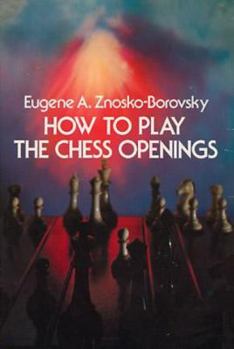How to Play the Chess Openings
Select Format
Select Condition 
Book Overview
Encourag par le succ s rencontr par son livre "Comment il ne faut pas jouer aux checs" paru en 1931, Eug ne Znosko-Barovsky se remit l'ouvrage en 1933 en d cidant cette fois de consacrer son talent de... This description may be from another edition of this product.
Format:Paperback
Language:English
ISBN:0486227952
ISBN13:9780486227955
Release Date:June 1971
Publisher:Dover Publications
Length:160 Pages
Weight:0.40 lbs.
Dimensions:0.3" x 5.4" x 8.0"
Customer Reviews
6 ratings
The only book you will need for chess openings
Published by GW , 2 years ago
I'm rated about 1800 and have been playing chess off and on since the 70's. I only had a few books over the decades to rely on. This was one of them. If the Dover Press hadn't made the paperback so unbelievably well, it would have fallen apart long ago. It is a book that I consult and study regularly. Yes the openings are old, but they are standard, proven openings the masters have used for 200 years. If you want to get to the end game, you have to have a good opening. This is where beginners should start and this is the book I would recommend for anyone.
As good as any
Published by Thriftbooks.com User , 14 years ago
This book was originally written in 1935. It is in descriptive notation (P-K4), 141 pages plus 7 pages of solutions to the 36 questions scattered through it. As its title suggests, it is about the general principles behind the different openings. The explanations are clear and easy to follow, and as good as any I've seen. It keeps things simple and doesn't list dozens of complex variations that would overwhelm a beginner. The fact that it is only $8 is icing on the cake. Recommended! I find only minor shortcoming for this sort of book. Algebraic notation would be better these days, but we have only the laziness of the publisher to blame for that. Descriptive notation should not deter a potential reader - it is no harder to learn than learning how a knight moves! The modern and hypermodern lines do not get coverage proportional to their current popularity. When the book was written, Alekhine's defence was new on the scene, and it got 3 pages. The Sicilian got 4 pages. Chess openings is a very difficult subject for beginners. When does the opening end and the middlegame start? How do I know that at the end of a given variation there are "about equal chances" or that "white has a slight advantage"? For general principles, this book is exactly what a beginner needs. For specific variations and their detailed analysis, things that only a serious chess player would worry about, one needs books that specialize in one opening or only one line (e.g. Sicilian Najdorf). To stay current, one needs the Chess Informant. The trouble with such books is that they get outdated very quickly. These days a better option is a computerized database, possibly with a subscription service to stay current. Computers have changed the way an advanced player studies openings. But the beginner still needs a book like this one. For a more modern introduction, with algebriac notation, I recommend Seirawan's book "Winning Chess Openings", ISBN 1857443497. It is thicker at 250 pages, but is easy to read. No single book will convert you from a beginner to a master - only hard work can do that. However, each book you read will put a little more wind in your sail.
In Descriptive Notation
Published by Thriftbooks.com User , 22 years ago
An excellent book which is not out-dated and for the price an absolute steal. Though some older opening books can be criticized as a tad bit out-date most can still be used today to learn the basics structures of different openings. Besides, the actual variations used in a game works better if it is your own creation rather than a memorized version and this applies to beginners as well as the experts. Excellent for intermediate players, but can also be used by all. If you are not comfortable with descriptive notations, GET COMFORTABLE! You will be missing out on a lot of excellent books (which are usually half the price). Being comfortable with descriptive as well as algabraic gives you the option and the flexibility to buy whatever chess books are out there, especially the best!
Notation
Published by Thriftbooks.com User , 24 years ago
The book is good if you can read the old notation. It left me frustrated from time to time because I'm so used to the new notation (ex. 1.e4)
The best single resource I have read on chess openings
Published by Thriftbooks.com User , 25 years ago
This book is very well structured. It is easy to read and will give the intermediate player a much better understanding of the chess openings. I really enjoyed the traps illustrated.
a classic but underated
Published by Thriftbooks.com User , 25 years ago
This book is the best book I have ever read on the openings in chess. The author recommends understanding of the openings rather than to try to memorize endless variations. After giving the first principles of the openings, he then shows how the openings should be played using these principles. He also devotes a section on exploiting the weak squares of your opponent. He classifies the openings under four catagories, which is very helpful in organizing the ideas behind these openings. This book is a masterpiece on opening theory and practice. Unfortunately, it is one of those books that goes largely ignored. Probably because people listen to "experts" too much, instead of thinking for themselves. This book is the best on the openings and cannot become "dated."





